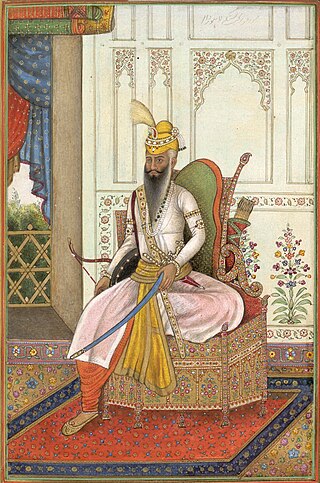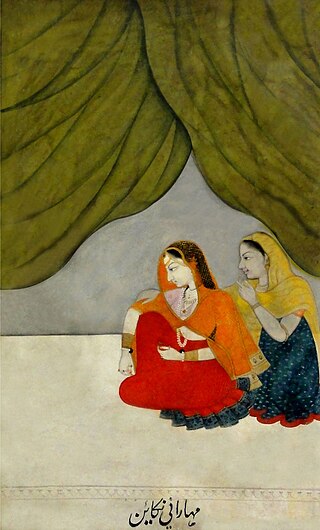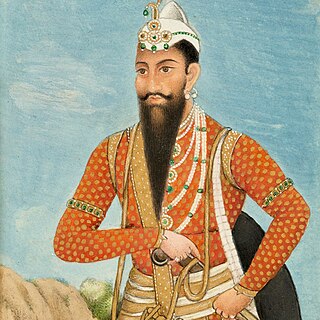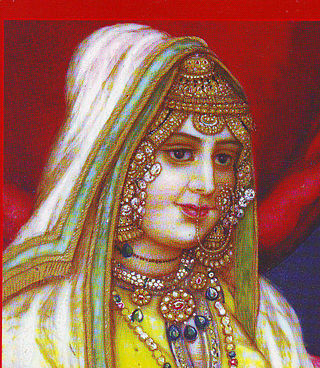
Ranjit Singh, popularly known as Sher-e-Punjab or "Lion of Punjab", was the first Maharaja of the Sikh Empire, which ruled the northwest Indian subcontinent in the early half of the 19th century. He survived smallpox in infancy but lost sight in his left eye. He fought his first battle alongside his father at age 10. After his father died around Ranjit's early teenage years, Ranjit subsequently fought several wars to expel the Afghans throughout his teenage years. At the age of 21, he was proclaimed the "Maharaja of Punjab". His empire grew in the Punjab region under his leadership through 1839.

Kunwar Nau Nihal Singh was the third Maharaja of the Sikh Empire. He was the only son of Maharaja Kharak Singh and his consort, Maharani Chand Kaur. He was known as Yuvraj Kunwar Nau Nihal Singh. He was also known as Bhanwar Singh or Bhanwar Sa or Kunwar Sa means Respected Young Prince. Bhawar means Son of Kunwar or Son of Thakur. His reign began with the dethronement of his father Maharaja Kharak Singh and ended with his death at the age of 19 on the day of his father's funeral.

Sher Singh was the fourth Maharaja of the Sikh Empire. Elder of the twins of Maharaja Ranjit Singh, founder of the Sikh Empire and Maharani Mehtab Kaur. His reign began on 18 January 1840 following his assault on Lahore which ended the brief regency of Maharani Chand Kaur. He was assassinated on 15 September 1843 by Ajit Singh Sandhawalia.

Hari Singh Nalwa was Commander-in-chief of the Sikh Khalsa Fauj, the army of the Sikh Empire. He is known for his role in the conquests of Kasur, Sialkot, Attock, Multan, Kashmir, Peshawar and Jamrud. Hari Singh Nalwa was responsible for expanding the frontier of Sikh Empire to beyond the Indus River right up to the mouth of the Khyber Pass. At the time of his death, the western boundary of the Empire was Jamrud.

Maharaja Gulab Singh Jamwal (1792–1857) was the founder of Dogra dynasty and the first Maharaja of the princely state of Jammu and Kashmir, which was a part of Panjab and Sikh Empire became the largest princely state under the British Raj, which was created after the defeat of the Sikh Empire in the First Anglo-Sikh War. During the war, Gulab Singh would later side with the British and end up becoming the Prime Minister of Sikh Empire. The Treaty of Amritsar (1846) formalised the transfer of all the lands in Kashmir that were ceded to them by the Sikhs by the Treaty of Lahore.

Maharani Datar Kaur (born Bibi Raj Kaur Nakai; was the queen consort of Maharaja Ranjit Singh, the founder of the Sikh Empire and the mother of his successor, Maharaja Kharak Singh. She was the daughter of Sardar Ran Singh Nakai, third ruler of the Nakai Misl and Sardarni Karmo Kaur.

Kharak Singh was the second Maharaja of the Sikh Empire. He was the eldest son of Maharaja Ranjit Singh, founder of the Sikh Empire and his consort, Maharani Datar Kaur. He succeeded his father on 27 June 1839 and reigned until his dethronement and imprisonment on 8 October 1839. He was succeeded by his only son Nau Nihal Singh.

Misr Diwan Chand was a notable officer and a powerful general of Maharaja Ranjit Singh's reign. He rose from petty clerk to the Chief of Artillery and Commander-in-chief of the armies that conquered Multan and Kashmir and also served as the Commander-in-Chief of Khalsa Army from 1816 to 1825. and was a notable pillar of the state.

Sham Singh Attariwala was a general of the Sikh Empire.

Akali Phula Singh Nihang was an Akali Nihang Sikh leader. He was a saint soldier of the Khalsa Shaheedan Misl and head of the Budha Dal in the early 19th century. He was also a senior general in the Sikh Khalsa Army and commander of the irregular Nihang of the army. He played a role in uniting Sikh misls in Amritsar. He was not afraid of the British who at many times ordered for his arrest but were not successful. During his later years he served for the Sikh Empire as a direct adviser to Maharaja Ranjit Singh. He remained an army general in many famous Sikh battles up until his martyrdom in the battle of Nowshera. He was admired by the local people and had a great influence over the land and his settlement was always open to help the poor and helpless. He was well known and was a humble unique leader and prestigious warrior with high character. He was also known for his effort to maintain the values of Gurmat and the Khalsa panth.

The Afghan–Sikh wars spanned from 1748 to 1837 in the Indian subcontinent, and saw multiple phases of fighting between the Durrani Empire and the Sikh Empire, mainly in and around Punjab region. The conflict's origins stemmed from the days of the Dal Khalsa, and continued after the Emirate of Kabul succeeded the Durrani Empire.

Maharani Mehtab Kaur was the first wife of Maharaja Ranjit Singh, the founder of the Sikh Empire. She was the mother of Ranjit's reputed son, Maharaja Sher Singh, who briefly became the ruler of the Sikh Empire from 1841 until his death in 1843.
Rani Raj Kaur was the wife of Maha Singh, the leader of the Sukerchakia Misl and the mother of Maharaja Ranjit Singh, the founder of the Sikh Empire. She was affectionately known as Mai Malwain after her marriage. She is also referred to as Sardarni Raj Kaur and was daughter of Raja Gajpat Singh Sidhu of Jind.
Kunwar Rattan Singh (1805–1845) was the second son of Maharaja Ranjit Singh, the founder of the Sikh Empire and his queen consort, Maharani Datar Kaur, though he was noted as an illegitimate child. His elder, Maharaja Kharak Singh was the second Maharaja of the Sikh Empire and nephew, Maharaja Nau Nihal Singh was the third Maharaja.
Sardar Kahan Singh Nakai was the sixth and the last chief of the Nakai Misl. He was the grandson of the famous Sikh chief, Ran Singh Nakai and Sardarni Karmo Kaur. His aunt, Maharani Datar Kaur was the wife of Maharaja Ranjit Singh, founder of the Sikh Empire; thus making him the nephew of the Sher-e-Punjab. From an early age he assisted his father in campaigns and even commanded campaigns assigned to him by his uncle, Maharaja Ranjit Singh. His cousin, Kharak Singh went to become the second Maharaja of the Sikh Empire. He was the uncle of the third Maharaja, Nau Nihal Singh.
Sardarni Karam Kaur popularly known as Karmo Kaur was the wife of Ran Singh Nakai,the third ruler of the Nakai Misl. She served as the regent of the Nakai Misl during the reign of her sons, Bhagwan Singh and Gyan Singh. Being the mother of Maharani Datar Kaur, she was the mother-in-law of Maharaja Ranjit Singh, the founder of the Sikh Empire. She was the grandmother of Maharaja Kharak Singh, the second king of the Sikh Empire and Sardar Kahan Singh Nakai, the last chief of the Nakai Misl.
Nanaki Kaur Atariwala (1823-1856) was the queen consort of Maharaja Nau Nihal Singh, the third Maharaja of the Sikh Empire. She was the daughter of the legendary general Sham Singh Atariwala.
Sahib Kaur (d.1841) was the second wife of Nau Nihal Singh, third Maharaja of the Sikh Empire and the mother of his son, Jawahar Singh.
Mian Ghaus Khan, also known as Mian Ghausa, was a Punjabi Muslim of Arain descent who served as an artillery officer of the Sukerchakia Misl under Sardar Maha Singh. After Maha Singh's death, Ghaus Khan served his son, Ranjit Singh, the founder of the Sikh Empire. Ghaus Khan's son, Sultan Mahmud Khan and grandson, Sultan Ahmad Ali Khan, too served in the Sikh Khalsa Army.
Diwan Bhawani Das was a high-ranking Hindu official under Durrani emperors, Zaman Shah and Shah Shujah. He later became the revenue minister of Maharaja Ranjit Singh, ruler of the powerful Sikh Empire.











